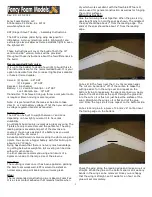
SECTION 8
CESSNA
HANDLING, SERVICE
MODEL 172RG
& MAINTENANCE
Figure 8-1. Additive Mixing Ratio
seals in the fuel system and engine components. Use only
blending equipment that is recommended by the manufac-
turer to obtain proper proportioning.
CAUTION
Do not allow the concentrated EGME compound to come in
contact with the airplane finish or fuel cell as damage can
result.
Prolonged storage of the airplane will result in a water buildup in the
fuel which "leeches out" the additive. An indication of this is when an
excessive amount of water accumulates in the fuel tank sumps. The
concentration can be checked using a differential refractometer. It is
i mperative that the technical manual for the differential refractometer
be followed explicitly when checking the additive concentration.
LANDING GEAR
NOSE WHEEL TIRE PRESSURE -- 40-50 PSI on 5.00-5, 6-Ply Rated Tire.
MAIN WHEEL TIRE PRESSURE -- 60-68 PSI on 15x6.00-6, 6-Ply Rated
Tires.
1 July 1979
8-14
Revision 1 - 15 July 1983
CESSNA
SECTION 8
MODEL 172RG
HANDLING, SERVICE
& MAINTENANCE
NOSE GEAR SHOCK STRUT --
Keep filled with MIL-H-5606 hydraulic fluid and inflated with air to 55
PSI with no load on strut.
HYDRAULIC FLUID RESERVOIR -- Check every 25 hours and service
with MIL-H-5606 hydraulic fluid.
CLEANING AND CARE
WINDSHIELD-WINDOWS
The plastic windshield and windows should be cleaned with an aircraft
windshield cleaner. Apply the cleaner sparingly with soft cloths, and rub
with moderate pressure until all dirt, oil scum and bug stains are removed.
Allow the cleaner to dry, then wipe it off with soft flannel cloths.
If a windshield cleaner is not available, the plastic can be cleaned with
soft cloths moistened with Stoddard solvent to remove oil and grease.
NOTE
Never use gasoline, benzine, alcohol, acetone, fire extin-
guisher or anti-ice fluid, lacquer thinner or glass cleaner
to clean the plastic. These materials will attack the plastic
and may cause it to craze.
Follow by carefully washing with a mild detergent and plenty of water.
Rinse thoroughly, then dry with a clean moist chamois. Do not rub the
plastic with a dry cloth since this builds up an electrostatic charge which
attracts dust. Waxing with a good commercial wax will finish the cleaning
job. A thin, even coat of wax, polished out by hand with clean soft flannel
cloths, will fill in minor scratches and help prevent further scratching.
Do not use a canvas cover on the windshield unless freezing rain or
sleet is anticipated since the cover may scratch the plastic surface.
PAINTED SURFACES
The painted exterior surfaces of your new Cessna have a durable, long
lasting finish and, under normal conditions, require no polishing or
buffing. Approximately 10 days are required for the paint to cure com-
pletely; in most cases, the curing period will have been completed prior to
delivery of the airplane. In the event that polishing or buffing is required
within the curing period, it is recommended that the work be done by
someone experienced in handling uncured paint. Any Cessna Dealer can
accomplish this work.
1 July 1979
8-15












































